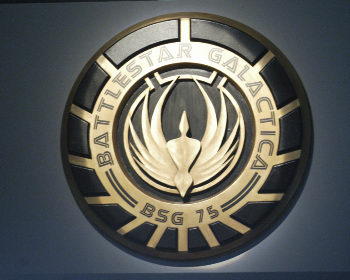
In 1978, the Cylons were a mechanical race of soulless metal and glass automatons bent on the destruction of the human race.
In 2003, this was the face of the Cylon threat:
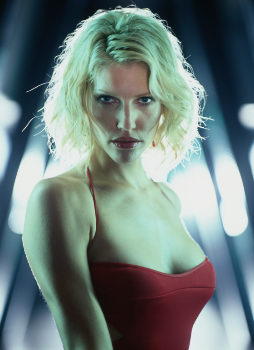
Although there were mechanical Cylons in the 2003 miniseries, they only appeared as props in the opening and closing scenes of the 4-hour production and served absolutely no function within the story. The focus was on human-looking Cylon infiltrators that primarily enticed the weak with sexual favors. The key Cylon first revealed to viewers was “Number 6”, a blonde bombshell who used her sexual expertise to dupe Gaius Baltar into revealing critical secrets.
A classic Cylon was briefly seen in a museum display case. These publicity shots were released prior to the airing of the miniseries and purported to show how the Centurion would be seen, but in the final release the images were replaced with a lower-quality rendering of a Centurion and seen only in passing. Like all of the icons from the original series, they were regarded as “relics”.
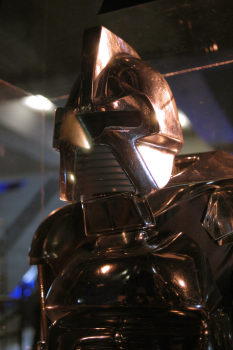
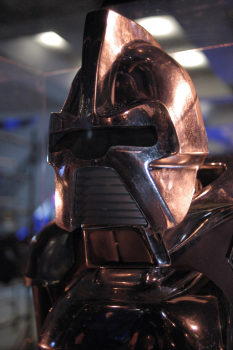
In the 1978 original, the Cylons were intent on destroying the humans for their interference in Cylon affairs. In the 2003 miniseries, they were intent on destroying their human “parents” and replacing them. However, as the weekly series unfolded in 2004 and beyond, after the twelve Colonial worlds and the bulk of the human population had been eradicated, the aims of the Cylons became less distinct and their goals became unclear.
As Glen Larson had originally drawn inspiration for the Cylon attack from the Japanese attack on Pearl Harbor, Ronald D. Moore took inspiration for his Cylon attack from the tragedy of September 11, 2001. But instead of a strict military hierarchy and the attempt to impose machine order to the universe, Moore’s Cylons were given a religious imperative similar to the attackers of 9/11: that the genocidal attack was in accordance with the wishes of their God and were just reparations for the abuse they had suffered at the hands of their creators. That was coupled with a Star Trek: The Next Generation “Borg Collective”-style concept that appeared to include many details used in that series, not the least of which was the transfer of intelligence upon the Cylon’s death to another – equally attractive – machine body.
The nature of the Cylon physiology morphed as the production of the 2003 miniseries and subsequent weekly series progressed. In the miniseries, the human-appearing Cylons were visually indistinguishable from their victims. However, they did possess greater physical strength than did a human, the silicon-based synaptic relays of their brains degraded in the presence of certain radiation, and elements along the spinal column glowed red while engaged in sexual activity (at least with the #6 model). These tell-tale attributes abruptly disappeared as the weekly series progressed and, despite an innate ability to access computer data by shoving fiber-optic cable into the forearm, the human-appearing Cylons were portrayed as indistinguishable from real humans at a microscopic, even molecular level. Even though they could access computer data by shoving fiber-optic cable into their forearm.
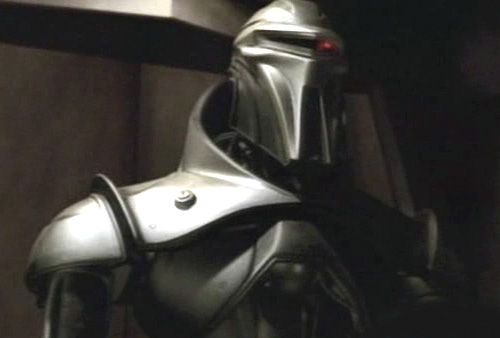
In coming up with a design for the mechanical Cylons, Eric Chu explained that he sought to design a more bug-like Cylon robot to support the human-looking infiltrators. His design came out of taking a fresh approach to the original Centurions, if not their design. Seeking a different look, the production team wanted the Cylons look to be meaner and less like a “man in a suit”. So, Eric introduced a more streamlined appearance, as if the robots were trying to emulate human anatomy, while keeping elements to suggest that they were members of a “hive”. Eric designed the armor details to look imposing and menacing even when unarmed and completely stationary. We did see more of the robotic Cylons during the run of the weekly series.
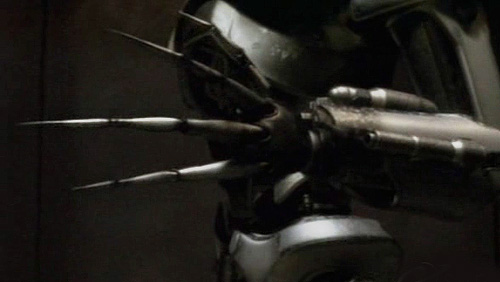
While we see the 2003+ Cylons treat certain individual Cylons with a degree of deference, it appeared to be situational; there was no clear Cylon leadership. The 2003+ series lacked any equivalent to the classic IL series (Lucifer) Cylons or the Imperious Leader, both of which played vital roles in the 1978 series.
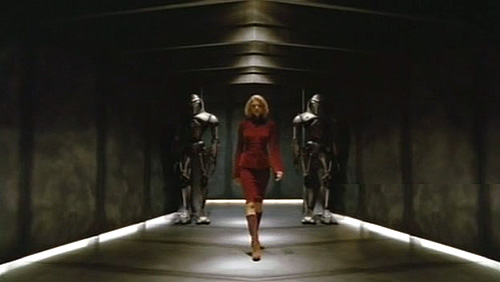
Written by John Pickard